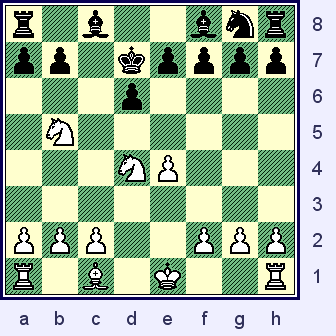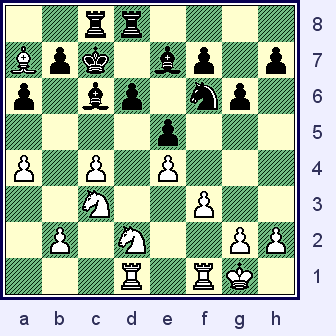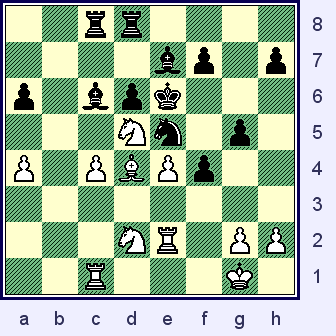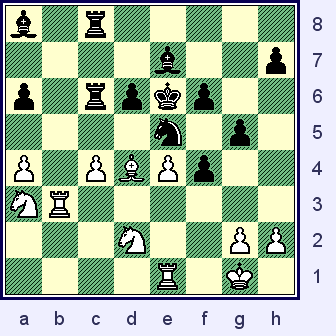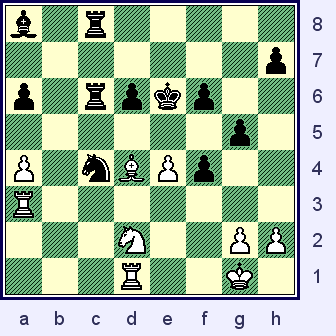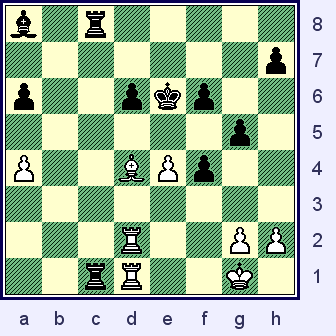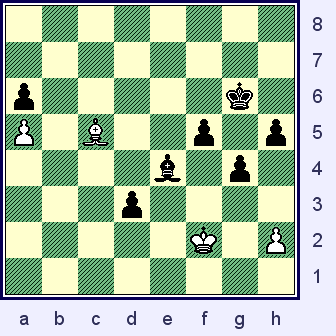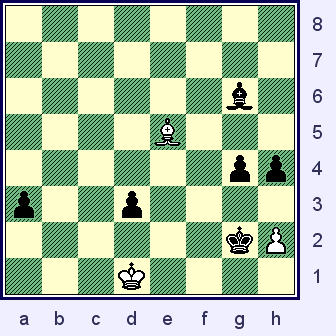All
the |
(Navigation bar
directly below.)
*******
© A.J. Goldsby, 2015.
(All rights reserved.)
****************
Click HERE
to see my
Chess Items.
****************
****************
Buy a book
from Amazon.com
(And help me out as well!)
****************
Click HERE
...
to see a list of the businesses that help to sponsor all of
my chess efforts.
My struggles with the program, Fritz 9.0 |
I had gotten burned out with playing chess on the Internet, lately I try to learn a new line, and then play it in blitz/speed chess with the computer. (I think this is a very good way to learn a new opening.)
The end result is that Fritz has been beating me like a drum. Some days - its kind of discouraging; a few times, I have built up very nice positions, only to have to computer hit me with an unforeseen tactic, or I make a blunder and the computer comes out on top. In one training game, (TL: Game in One hour); I was two Pawns ahead (as White), but the dang program snaked me somehow - in a setting where no tactics looked possible.
The computer saves all of its games to an "Autosave" file, one time, I had lost over 100 games in a row in blitz chess, before I was able to get a single draw. Of course, a few times, I thought I had what was close to a won position, but I either missed a tactic or ran out of time.
Its not all bad, below is a game that I drew the computer in blitz, straight-up, with no handicap whatsoever.
Click HERE to see an explanation of the symbols I use when annotating a chess game.
A.J.
Goldsby I (2250) - Fritz 9 (2860)
|
In slow chess, (training games); the results were even more discouraging than those in speed, if that is even possible. At one point, the computer had defeated me like 15 games in a row. (Before I got a nice draw as Black in a Nimzo-Indian defense opening.)
All this changed last night ... when I managed to win my first game ever ... of any kind ... versus the mighty machine.
Fritz 9.0
(2750) - NM A.J. Goldsby I (2300)
|
|
|
[A.J. Goldsby I]
I finally defeat Fritz 9, but it is a
very strange game. (This is the 33rd game in a database full of
losses, although I did get two draws in that group of games as well.)
The time control was "Game in 45
minutes," with one second per move.
(I had a tad more time, {15 min}; plus
ten seconds per move.) Other than a time advantage, I did not handicap the engine in any way. (It had like
500 MB of RAM for the hash-tables ... and also access to the 2005 Fritz Power-Book. I had optimized the
engine before the game.)
***********************************************************************************************************
1.e4 c5;
2.Nf3 d6; 3.d4 cxd4; 4.Qxd4!?,
A tad unusual, but this is in Fritz's opening book, and he plays it from time to time.
Of course the normal move here
is to play 4.Nxd4, with a standard Open Sicilian.
[See MCO-14 for more details on the lines of the Open Sicilian.]
4...Nc6;
5.Bb5 Qa5+!?;
An unusual line, and the way that I played this variation the very first time that I saw
it in tournament play.
[ The "book" line is:
5...Bd7; 6.Bxc6 Bxc6; 7.Nc3 Nf6; 8.Bg5 e6; 9.0-0-0 Be7;
10.Rhe1 0-0; 11.Qd2, "+/=" with a solid plus for White.GM M. Tal - GM R. Byrne; (FIDE) Interzonal Tournament /
(R#13); Biel, Switzerland, 1976.
{White won a nice game, a huge crush in only 22 moves.}But see also:
GM Joel Lautier - GM Jan Timman; / ICT, Investebank Masters
(R#10) / Belgrade, Yugoslavia; 1995. / {Black won a long game.}[ See a specialized openings book, like "The Encyclopedia of
Chess Openings" (ECO), for more details. ] ]
6.Nc3 Qxb5!?;
7.Nxb5 Nxd4;
8.Nfxd4 Kd7!?; {Diagram below.}
The computer had some sort of weird melt-down here ...
and the box now proceeded to use over 30 minutes of its total allotment of time.
Strange!!!
|
|
r1b2bnr/pp1kpppp/3p4/1N6/3NP3/8/PPP2PPP/R1B1K2R w
Take a look at the board ... and decide for yourself which side of this contest you would rather play.
9.c4 e6;
(protects the vital d5-square)
A sensible move ... I have to keep White's Knights at bay until I manage to get in some development.
10.0-0 a6;
11.Nc3 Kc7; 12.Be3, "+/=" 12...Nf6; 13.f3 Be7;
14.Rad1, (hmmm, bad?)
A case of the wrong Rook ... at least to me.
(In this position, White's 'heavies' belong on d1 and c1, so >/= 14.Rac1.)
14...Bd7;
15.Nb3 Bc6;
16.a4 Rac8; 17.Bd4 Rhd8;
This Rook might be better placed on g8 ... to avoid a traffic jam.
18.Nd2 e5!?;
I wanted to limit the scope of White's Bishop ... but this could be a doubtful idea, Fritz suggests
>/= 18...Ne8; and this is probably better than the actual game.
19.Ba7!? g6!?;
(Maybe - '?!') {Diagram
below.}
Extremely provocative play on my part ... although I was not really trying to play this way intentionally.
|
|
2rr4/Bpk1bp1p/p1bp1np1/4p3/P1P1P3/2N2P2/1P1N2PP/3R1RK1 w
Now the game quickly reaches a crisis ... the tension and threats are greatly increased.
[ It was probably safer to play:
>/= 19...b6; 20.a5 Nd7; 21.b4 Bg5; 22.Rfe1, "+/="
with only a small edge for White. ]
Now White's next move is inferior to the idea of simply a5, which threatens to win material w/Bb6+.
20.Rc1!? Kd7!?;
('?')
It seems to make sense to get off the file ... but now Fritz considers its position to be winning by over two full points. (Maybe
>/= 20...b6.)
21.b4 Ke6;
(Was e8 safer?)
Now Fritz thinks it is winning by over three points ... yet it is now running very short of clock time.
22.b5 Be8;
23.f4 exf4[];
I felt that this was forced.
24.bxa6 bxa6;
25.Bd4,
Fritz still thinks it is better, but ... for whatever reason ... it will not just recapture the f-pawn.
[ After the moves: 25.Rxf4 Nd7; "=" Black looks OK. ]
Now I decide to simply keep the button on f4 ... doubled or not.
25...g5!?;
26.Rfe1 Nd7;
27.Nd5 Ne5; 28.Re2 Bc6; "=/+" {Diagram
below.}
Here I had a sense of fatalism ...
(that borders on a form of hypnosis); I am a solid pawn up. Yet the box had thumped me so many times, I was convinced that a checkmate must be right around the corner for me from the
current board set-up.
|
|
2rr4/4bp1p/p1bpk3/3Nn1p1/P1PBPp2/8/3NR1PP/2R3K1 w
Black has managed to survive the opening ... and not get killed.
{A minor miracle, all things considered.}
29.Rc3 f6;
30.Nb4 Bb7;
31.Nc2 Rd7!?;
My first impulse was to play the awful 31...Rc7??; with the exact same idea.
(Double the Rooks.)
Thankfully, I caught myself just before a played a major blunder.
32.Re1 Rdc7;
33.Na3 Rc6;
34.Rb3 Ba8; {Diagram
below.}
And here I felt one of those "ZINGERS" ... (A cruel, winning tactic, that comes out of nowhere, and wins the game for the machine.) ... must be in my near future.
|
|
b1r5/4b2p/p1rpkp2/4n1p1/P1PBPp2/NR6/3N2PP/4R1K1 w
I honestly felt I was OK here, but also felt a sense of hopelessness ...
(I had good positions before, but I had always managed to blow it.).
35.Rc3!? Bd8!;
(Very nice!)
Now I (finally) began to feel good about my position, my "bad" Bishop will emerge on a5.
36.Rc2 Ba5;
37.Rd1 Bb4;
38.Ra2 Bxa3; 39.Rxa3 Nxc4; {Diagram
below.}
Now I was thinking something like, "I am two Pawns up! How's the machine going to manage to save this position?"
|
|
b1r5/7p/p1rpkp2/6p1/P1nBPp2/R7/3N2PP/3R2K1 w
Take a look at this position ... and see which side you would rather be on now.
40.Rd3 Nxd2;
41.R3xd2 Rc1!;
42.Bb2 Rxd1+; 43.Rxd1 Bxe4; {Diagram
below.}
44.Ba3 d5;
45.Rc1, (Capitulation.)
{Black had threats of ...Rc2.}
Now I knew as long as I did not blunder, I had the game in the bag ... I am only three Pawns ahead!
|
|
2r5/7p/p3kp2/3p2p1/P3bp2/B7/6PP/2R3K1 b
Not only does Black have an advantage in material, White's two pieces have almost no way to combine against any of the second player's weak points.
[ >/= 45.Rd2 a5!; "-/+" ]
The rest needs no comment.
(Maybe I don't play the ending perfectly, but well enough to win this one.)
45...Rxc1+;
46.Bxc1 Ke5;
47.Kf2 g4; 48.a5 d4;
49.Ba3 h5; 50.g3 f5;
51.gxf4+ Kxf4;
52.Bd6+ Kg5;
53.Be7+ Kg6; 54.Bc5 d3; {Diagram
below.}
(I did wonder if I had managed to blow the win here, endings with just opposite-colored Bishops are full of drawing possibilities. Once before, I had been many Pawns ahead, but had
to return them to avoid being mated. Then the box saved a position in the endgame that involved Bishops that travel on different coloured squares, even though the program was two pawns
down.)
|
|
8/8/p5k1/P1B2p1p/4b1p1/3p4/5K1P/8 w
Black probably has a win from here, and it does not take a ton of technique to make it happen.
********************************************************************************************************
55.Bd6 Kf7;
56.Bf4 Ke6;
57.Ke3 Kd5; 58.Bg5 Kc4;
59.Kd2 Kb4;
60.Bd8 f4;
61.Bc7 Bg6!?;
The move 61...f3 might have been a little more accurate.
(Now Fritz must deal with a passed QRP.)
62.Bxf4 Kxa5;
63.Bg5 Kb4;
64.Be7+ Kb3; 65.Bd8 Kb4;
66.Be7+ Kb5; 67.Kc3 a5;
68.Bf6 Kc6;
69.Bg5 Kd5;
70.Bd8 a4; 71.Be7 Ke4;
72.Kd2 Kf3; 73.Kd1 Kg2;
74.Bd6 h4;
75.Be5 a3; "-/+" {Final diagram - below.}
Here the box shocked the mess out of me by actually resigning.
(I ran outside and had to run around for a little bit, I was so incredibly excited.)
|
|
8/8/6b1/4B3/6pp/p2p4/6kP/3K4 w
This was not a pretty game, an elegant crush like some of the other "anti-computer games" that I have played. [one example] (And I still do not really understand what the box missed, or if it just failed to properly evaluate the position.) However, I am very happy with my first victory ... of any kind ... over this program. (Defense and the endgame might be the only way to defeat the computers of today.)
Copyright (c) A.J. Goldsby, 2006. All rights reserved.
0 - 1
The analysis for this page was prepared with the excellent programs, ChessBase 8.0 and ChessBase 9.0.
The HTML was polished with several different tools and programs, (mostly FP) ... the text was checked for spelling with MS Word.
The diagrams were created with the program, Chess Captor 2.25.
|
Click HERE to - go to or return - to my HOME PAGE ... for this site. Click HERE to go (or return) to my site map (page). Click HERE to go (or return) to my "Annotated Games I" (page). Click HERE to go (or return) to my "Annotated Games II" (page). Click HERE to go (or return) to "My Games" (page). (Or you could use the "Back Button" on your web browser.) Copyright (c) LM A.J. Goldsby I Copyright (©) A.J. Goldsby, 2009. All rights reserved. ******* This page was first created in July 2006. It was first posted: 07/22/2006. It was last updated on: July 14, 2012 02:16 AM . |
